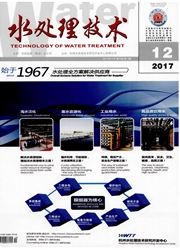

 中文摘要:
中文摘要:
对比考察了粉末活性炭(PAC)强化膜生物反应器(MBR)工艺和单独MBR工艺对污水中酰胺咪嗪、萘普生、新诺明和双氯芬酸钠4种药物的去除效能,同时采用聚合酶链式反应一变性梯度凝肢电泳(PCR.DGGE)技术对2种工艺中的微生物群落结构变化进行了分析。结果表明,与单独MBR工艺相比,PAC强化MBR工艺对4种药物的去除效率分别提高了25%、17%、22%和16%。在反应的开始阶段,2种处理工艺中微生物的种类较为单一且差异较小;运行8个月以后,2种反应器中微生物的种类增加,主要为α-变形菌、β-变形菌、γ-变形菌、6.变形菌、拟杆菌、鞘脂杆菌、杆菌和放线菌等,在PAC强化MBR反应器中还出现了新诺明降解菌等药物降解菌。由此可见,在MBR中投加PAC不仅能够通过吸附作用在较短时间内提高对污水中药物的去除效果,还有利于特异性药物降解微生物在反应器内衍生和积累,进一步提高了对药物的长期稳定去除效果。
 英文摘要:
英文摘要:
PAC enhanced MBR and single MBR were used to remove carbamazepine, diclofenac sodium, naproxen and sulfamethoxazole. In this process, Polymerase chain reaction-denaturing gradient gel electrophoresis (PCR-DGGE) technology was used to analyze microbial community changes. The results showed that the enhanced MBR reactor exhibited higher average removal efficiency for carbamazepine, diclofenac sodium, naproxen and sulfamethoxazole about 25%, 17%, 22% and 16% than the one without PAC. At the beginning, the microbial species of the two systems were similar. Atter eight months of the operation, microbial species in both two processed increased, mainly including α-Proteobacteria, β-Proteobacteria, γ-Proteobacteria, 8-Proteobacteria, Bacteroides, sphingolipids bacillus, Bacteroidetes, actinomycetes et al. More pharmaceuticals biodegradation bacterium, such as sulfamethoxazole biodegradation bacterium, was found in the PAC-MBR process. Therefore PAC dosed in the MBR not only absorbed pharmaceuticals in short term, but also promoted the microbial diversity to improve pharmaceuticals removal in long term.
 同期刊论文项目
同期刊论文项目
 同项目期刊论文
同项目期刊论文
 Photodegradation of amoxicillin in aqueous solutionunder simulated irradiation: influencing factorsa
Photodegradation of amoxicillin in aqueous solutionunder simulated irradiation: influencing factorsa Co-production of activated carbon, fuel-gas, and oil from the pyrolysis of corncob mixtures with wet
Co-production of activated carbon, fuel-gas, and oil from the pyrolysis of corncob mixtures with wet Removal of five selected pharmaceuticals by coagulation in the presence of dissolved humic acids and
Removal of five selected pharmaceuticals by coagulation in the presence of dissolved humic acids and Photodegradation of amoxicillin in aqueous solution under simulated irradiation: influencing factors
Photodegradation of amoxicillin in aqueous solution under simulated irradiation: influencing factors Contribution of sludge adsorption and biodegradation to the removal of five pharmaceuticals in a sub
Contribution of sludge adsorption and biodegradation to the removal of five pharmaceuticals in a sub Determination of selected pharmaceuticals in tap water and drinking water treatment plant by high-pe
Determination of selected pharmaceuticals in tap water and drinking water treatment plant by high-pe Influencing factors and degradation behavior of propyphenazone and aminopyrine by free chlorine oxid
Influencing factors and degradation behavior of propyphenazone and aminopyrine by free chlorine oxid 期刊信息
期刊信息
